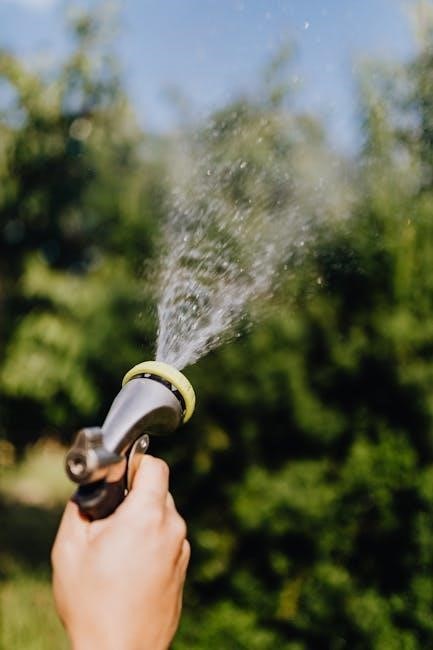Manual pumps for well water are cost-effective, eco-friendly solutions for water extraction, offering reliability during power outages and suitability for various well depths.
1.1 What is a Manual Pump?
A manual pump is a hand-operated device used to extract water from wells. It relies on mechanical motion to create suction and deliver water. No electricity is required, making it a simple, portable solution. Ideal for shallow wells, manual pumps are durable and eco-friendly, offering a reliable water supply in various settings, especially off-grid.
1.2 Importance of Manual Pumps in Water Supply
A manual pump is a reliable, eco-friendly solution for water supply, especially in rural or off-grid areas. It ensures access to clean water without electricity, making it ideal for emergencies and sustainable living; Its simplicity and durability provide a cost-effective alternative for households, promoting water independence and supporting communities during power outages or natural disasters.

Types of Manual Pumps for Well Water
Manual pumps for well water include shallow-well, deep-well, and hand-operated jet pumps, each designed for specific water depths and operational needs.
2.1 Shallow-Well Pumps
Shallow-well pumps are designed for wells with water depths of up to 25 feet. They are typically installed above ground or in basements, making them easy to access and maintain. These pumps are ideal for small water needs and are often used as backup systems. Their simple design ensures cost-effectiveness and reliability for basic water supply requirements.
2.2 Deep-Well Pumps
Deep-well pumps are engineered for wells exceeding 25 feet in depth, often reaching up to 100 feet. These pumps are typically submerged below the water surface, ensuring efficient extraction of water from deeper aquifers. Their robust design makes them suitable for consistent water supply in areas where water tables are low. Regular maintenance is essential for optimal performance and longevity.
2.3 Hand-Operated Jet Pumps
Hand-operated jet pumps are versatile, suitable for both shallow and deep wells. They use a jet of water to create suction, lifting water to the surface efficiently. These pumps are lightweight, portable, and ideal for emergency or backup systems. They require minimal installation and are a practical choice for remote locations where electricity is unavailable or unreliable.
How Manual Pumps Work
Manual pumps operate by converting mechanical energy from a handle into suction, drawing water from the well through a valve system to the surface efficiently.
3.1 Basic Mechanism of Manual Pumps
A manual pump works by converting hand motion into mechanical energy, creating suction that lifts water from the well. As the handle is moved up and down, a piston inside the pump alternates between drawing water into the cylinder and pushing it upward through a discharge valve to the surface. This simple mechanism ensures efficient water extraction with minimal effort.
3.2 Suction and Delivery Strokes
During the suction stroke, the piston descends, creating a vacuum that draws water from the well through the intake valve. As the piston rises, the intake valve closes, and the water is pushed upward through the delivery valve to the surface. This continuous cycle of suction and delivery efficiently pumps water with each manual operation.
Installation of a Manual Pump
Proper installation involves selecting a suitable location, ensuring alignment, and securing the pump. Follow step-by-step guides to ensure safe and effective water delivery from your well.
4.1 Choosing the Right Location
Selecting the optimal location for a manual pump involves ensuring easy access, proximity to the well, and protection from environmental factors like flooding or extreme temperatures. Level ground is essential to prevent pump misalignment and ensure smooth operation. Additionally, the location should be close to the well casing to minimize suction issues and maximize efficiency, while also being accessible for maintenance and repairs. Proper placement ensures durability and effective water delivery.
4.2 Step-by-Step Installation Guide
Install the pump by first connecting it to the well casing and ensuring proper alignment. Use a rod to guide the pump into place, then secure it tightly. Check all connections for leaks and test the pump by operating it several times to ensure smooth water flow. Regularly inspect and maintain the setup to prevent malfunctions and extend its lifespan.
Maintenance and Troubleshooting
Regular lubrication of moving parts and checking for leaks are essential. Troubleshoot issues like low water flow by inspecting the pump’s suction or delivery strokes for blockages.
5.1 Regular Maintenance Tips
Regular maintenance ensures optimal performance of manual pumps. Check for worn or corroded parts and replace them promptly. Lubricate moving components to reduce friction and wear. Inspect the pump’s seals and gaskets for leaks, as water loss can decrease efficiency. Clean the suction screen regularly to prevent clogs and ensure smooth water flow. Schedule annual deep cleanings to remove mineral buildup and maintain hygiene.
5.2 Common Issues and Solutions
Common issues with manual pumps include leaks, jammed handles, and low water flow. Leaks can be fixed by replacing worn gaskets or seals. Jammed handles may require lubrication or adjusting alignment. For low flow, clean the suction screen or check for blockages in the piping. Regular inspection and timely repairs prevent major breakdowns and ensure consistent water supply.

Advantages of Manual Pumps
Manual pumps offer reliability without electricity, cost-effectiveness, and eco-friendly operation, making them ideal for emergencies and sustainable water access in off-grid locations.
6.1 Cost-Effectiveness
Manual pumps are a budget-friendly option for well water extraction. They require minimal installation costs and no electricity, reducing long-term expenses. Their durability and low maintenance further enhance their affordability, making them a practical choice for homeowners seeking a cost-efficient water supply solution. This financial advantage is particularly beneficial in rural or off-grid settings.
6.2 Environmental Benefits
Manual pumps are eco-friendly, operating without electricity and reducing carbon emissions. They promote sustainable water use by conserving resources and minimizing energy consumption. Their simple design limits environmental impact, making them ideal for environmentally conscious users. This aligns with green living principles and supports water conservation efforts effectively.
6.3 Reliability During Power Outages
Manual pumps are a reliable backup solution during power outages, ensuring continuous water access without electricity. Their simplicity and independence from power grids make them an essential emergency tool. This feature is particularly valuable in rural or off-grid areas, providing peace of mind and functionality when traditional systems fail.
Comparison with Electric Pumps
Manual pumps offer a cost-effective, eco-friendly alternative to electric pumps, ideal for low-flow needs and off-grid reliability, contrasting with electric pumps’ higher efficiency but dependency on power.
Manual pumps operate without electricity, relying on physical effort, making them ideal for off-grid or emergency use. Electric pumps, while more efficient for high-flow needs, depend on power. Manual pumps are eco-friendly, cost-effective, and durable, whereas electric pumps require maintenance and pose environmental impacts. Each suits different scenarios, balancing convenience against sustainability and energy reliance. Manual pumps are ideal for shallow wells, remote areas, or emergency backup systems. They’re perfect for off-grid communities, offering reliability during power outages. For low-cost, eco-friendly solutions with minimal maintenance, manual pumps are a practical choice for small-scale water needs, ensuring sustainable access without electricity dependency. When selecting a manual pump, assess water depth, flow rate, and pump durability. Consider material quality and suitability for your specific well conditions to ensure optimal performance. Choosing the right manual pump requires evaluating the water depth and desired flow rate. Shallow wells may need smaller pumps, while deeper wells demand more robust models. Assessing these factors ensures efficient water extraction and optimal pump performance, matching your specific needs for reliable water supply without overexertion or underdelivery. Proper sizing is crucial. Durability and material quality are vital for a long-lasting manual pump. Stainless steel and durable plastics resist corrosion, ensuring reliability over time. High-quality materials withstand harsh environments, reducing maintenance needs and extending pump life. Investing in durable components guarantees consistent performance and reduces the risk of premature wear, making it a cost-effective choice for sustainable water access. Manual pumps require careful operation to ensure user safety. Regular inspections prevent mechanical failures, while proper handling avoids injuries. Always follow installation and maintenance guidelines to ensure safe and efficient water extraction.
Operating a manual pump requires attention to detail to ensure safety. Start by ensuring the pump is securely installed and all moving parts are well-lubricated. Always use the handle correctly, avoiding excessive force that could cause injury or damage. Check for leaks regularly and never leave the pump unattended while in use. Keep children away from the pump to prevent accidents. Proper operation not only extends the pump’s lifespan but also ensures reliable water supply. Regular inspections and maintenance are crucial to uphold safety standards and prevent mechanical failures. By following these guidelines, you can operate the pump safely and effectively. Preventing contamination is vital to maintain clean water from your well. Regularly inspect the pump and surrounding area for any signs of damage or wear. Ensure the pump is sealed properly to prevent foreign particles or bacteria from entering. Use high-quality, durable materials for all components. Keep the well casing covered and avoid storing chemicals nearby. Regular maintenance and testing can help identify potential issues early. Always clean the pump handle and moving parts after use. Proper storage and handling of equipment are essential to prevent contamination. By following these steps, you can ensure a safe and reliable water source. Manual pumps for well water are eco-friendly, reducing reliance on electricity and lowering carbon emissions. They promote sustainable water usage by allowing users to draw only what’s needed. Manual pumps are eco-friendly, requiring no electricity and minimizing carbon emissions. They rely on human power, making them sustainable and energy-efficient. This reduces environmental impact and promotes green living. Additionally, manual pumps help conserve water by allowing users to draw only what’s needed, preventing waste and preserving natural resources effectively. Manual pumps encourage sustainable water usage by allowing precise control over extraction. This prevents over-pumping and preserves groundwater levels. Their operation fosters water conservation, ensuring that water is used responsibly. This method supports long-term aquifer health, making it an ideal solution for communities focused on environmental sustainability and resource management. Manual pumps are widely used in rural areas and emergency systems, providing reliable water access without electricity. They serve as essential tools in off-grid communities. Manual pumps are essential in rural areas where electricity is scarce, providing reliable access to well water for drinking and irrigation. Manual pumps excel as emergency backup systems during power failures or natural disasters, ensuring continuous water access. Manual pumps have proven indispensable in off-grid communities, providing reliable water access during emergencies and power outages, showcasing their practicality and effectiveness in real-world scenarios. Manual pumps have revolutionized water access in off-grid areas, providing a sustainable and reliable solution. Their simplicity and energy independence make them ideal for remote regions, ensuring consistent water supply without electricity. This has improved health, agriculture, and overall quality of life in many communities worldwide, proving their effectiveness in challenging environments. Users praise manual pumps for their reliability and simplicity. One homeowner shared, “It’s a lifesaver during power outages—never missed a day without water.” Another testified, “Easy to install and maintain, it’s the perfect backup for our well water needs.” A rural resident added, “It’s durable and efficient, ensuring clean water for my family consistently.” Manual pumps offer reliable, eco-friendly, and cost-effective water solutions, ensuring access during power outages and promoting sustainable water use for generations. Manual pumps are a reliable and sustainable solution for accessing well water, offering cost-effectiveness and environmental benefits. Their simplicity ensures functionality during power outages, making them ideal for off-grid communities. With proper maintenance, these pumps provide a durable and eco-friendly alternative to electric systems, ensuring consistent water supply for various needs. The future of manual pump technology lies in innovation, with advancements in materials and smart integrations. Expect lightweight, durable designs and eco-friendly materials. Integration with monitoring systems could enhance efficiency. These pumps will remain vital for sustainable water access, especially in remote areas, ensuring reliability and environmental benefits for generations to come.7.1 Manual vs. Electric Pumps: Key Differences
7.2 When to Choose a Manual Pump

Factors to Consider Before Buying
8.1 Water Depth and Flow Rate
8.2 Durability and Material Quality
Safety Precautions
9.1 Operating a Manual Pump Safely
9.2 Preventing Contamination

Environmental Impact
10.1 Eco-Friendly Nature of Manual Pumps
10.2 Sustainable Water Usage

Real-World Applications
11.1 Use in Rural Areas
Their simplicity and durability make them ideal for off-grid communities, ensuring sustainable water supply without dependence on power grids.
They also serve as emergency backup systems, guaranteeing water availability during outages or natural disasters.11.2 Emergency Backup Systems
Their reliability and ease of use make them a critical component in preparedness plans, providing a sustainable solution for households and communities.
Case Studies and Success Stories
12.1 Effective Use in Off-Grid Communities
12.2 User Testimonials
13.1 Final Thoughts on Manual Pumps
13.2 Future of Manual Pump Technology
